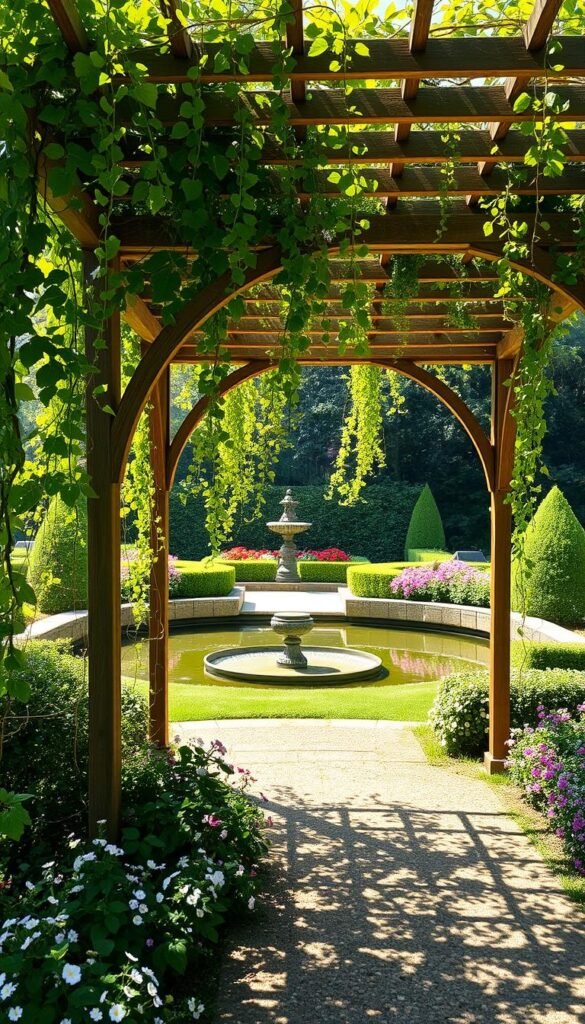Vertical structures have revolutionized how we cultivate greenery in limited areas. What began as basic 19th-century frameworks now serve as multipurpose design elements that transform blank walls into living masterpieces. These innovative supports help vegetation reach sunlight while adding artistic flair to your landscape.
Modern versions combine practical function with visual appeal. They create natural privacy screens for patios while showcasing flowering vines like morning glories or clematis. Urban dwellers particularly appreciate how these space-saving systems turn concrete balconies into lush retreats.
The evolution of vertical gardening solutions offers exciting possibilities. From repurposed materials to geometric metalwork, today’s designs blur the line between plant support and outdoor sculpture. Our guide to DIY vertical gardening solutions demonstrates how adaptable these structures can be for different environments.
You’ll discover how strategic placement enhances both plant health and visual interest. Properly positioned frameworks improve air circulation while creating striking focal points. Whether nurturing edible vines or decorative blossoms, the right structure turns ordinary growth patterns into captivating displays.
Upcoming sections reveal innovative approaches that merge practicality with imagination. Learn to select materials that withstand weather while complementing your existing decor. Transform overlooked vertical surfaces into thriving ecosystems that delight the senses year-round.
Enhancing Your Garden with Creative Trellis Designs
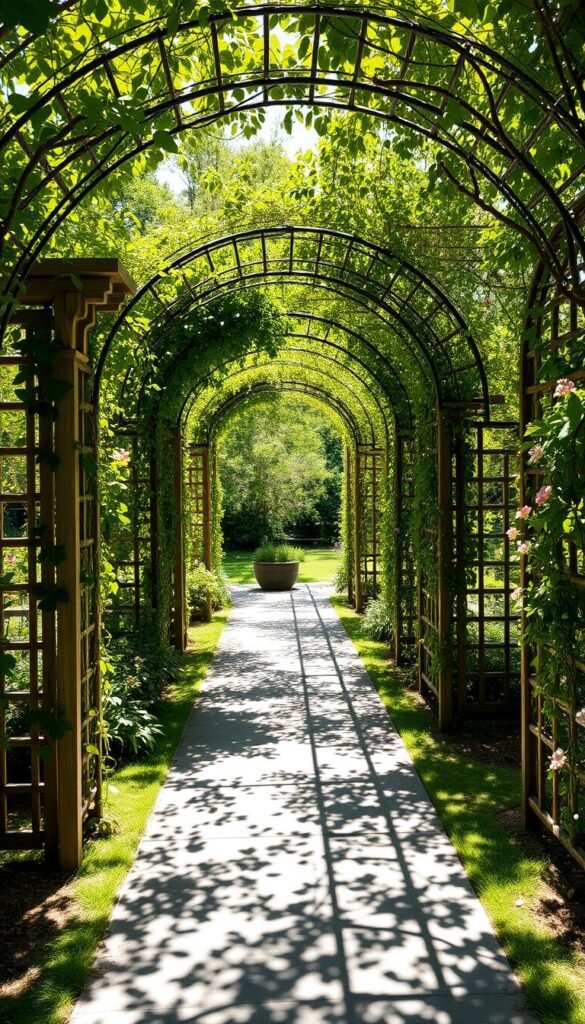
Transform your yard or balcony with structures that blend form and function. Today’s vertical supports do more than hold vines – they create living artwork while solving space challenges. These adaptable frameworks turn plain walls into dynamic green showcases.
Why Vertical Supports Matter
Modern versions serve triple duty: plant guides, privacy providers, and style statements. They help greenery thrive upward while blocking unwanted views. Urban growers love how these systems maximize tight spots – think balcony dividers that host jasmine or tomatoes.
What’s Hot in Structural Design
Current favorites include sleek metal grids and warm wood lattices. Many homeowners mix materials for unique looks. Check out how different options compare:
| Feature | Traditional | Modern |
|---|---|---|
| Materials | Wood only | Metal + composite |
| Function | Basic support | Multi-use screen |
| Visual Appeal | Simple patterns | Geometric shapes |
| Space Fit | Large yards | Any size area |
Slatted panels lead current trends, offering clean lines that work with climbing roses or veggies. Their angled designs cast beautiful shadows even before plants fill in. For timeless charm, stained cedar screens remain popular – they age beautifully while supporting wisteria or grapes.
Choosing the Ideal Trellis Materials and Designs
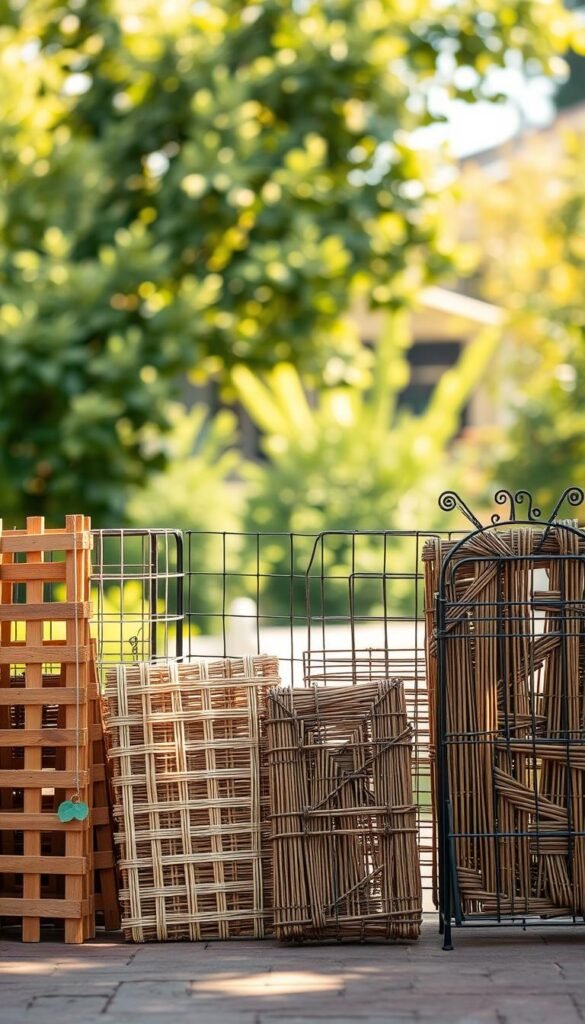
A trellis’s effectiveness depends on matching materials to your green space’s needs. The right combination enhances plant growth while complementing your outdoor aesthetic. Let’s explore options that balance practicality with visual charm.
Comparing Wooden, Metal, and Rope Trellises
Cedar stands out among wooden choices for its natural resistance to rot and insects. Its spaced horizontal slats create striking shadow patterns as sunlight filters through. Metal options like stainless steel cables offer sleek lines perfect for modern settings – they virtually disappear when vines fill in.
| Material | Durability | Best For |
|---|---|---|
| Wood | 5-15 years | Traditional gardens |
| Metal | 20+ years | Contemporary spaces |
| Rope | 3-7 years | Temporary setups |
Rope systems work well for lightweight annuals but need frequent replacement. For permanent structures, marine-grade stainless steel outperforms other metals in harsh weather. Consider your climate and plant types when choosing.
How to Pick Materials You Already Have at Home
Look around your property before shopping. Fallen branches become rustic supports for peas or beans. Old wooden ladders make instant A-frame structures when secured properly. Even leftover rebar from building raised beds can anchor homemade frameworks.
Bamboo stakes tied with twine create inexpensive grids for morning glories. Pallet wood transforms into vertical planters with some creative dismantling. The key is assessing each material’s weight capacity and weather resistance.
8 Garden Trellis Ideas to Support Climbing Plants Creatively
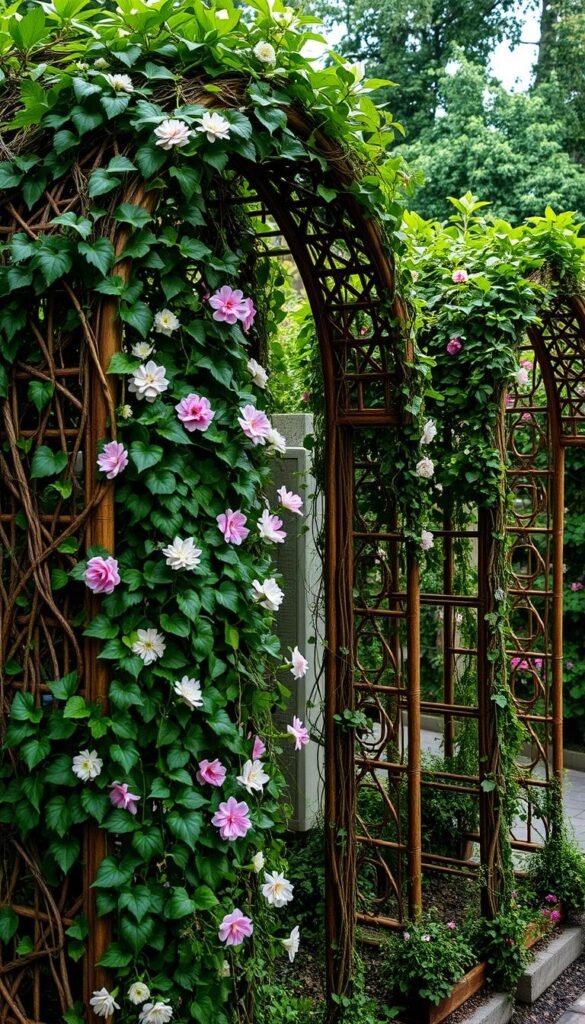
Your outdoor area becomes a canvas when reimagining vertical surfaces. Strategic frameworks merge artistry with botany, turning functional supports into conversation starters. Let’s explore how dual-purpose solutions enhance both urban balconies and sprawling backyards.
Multi-Functional Designs for Urban and Rural Spaces
City dwellers love folding screens that moonlight as plant guides. The Garden Trellis Co. offers powder-coated metal grids that partition patios while supporting passionfruit vines. Rural settings benefit from cedar lattices that section off herb gardens from seating areas naturally.
Jakob rope systems shine in compact settings. Their nearly invisible cables create floating green walls perfect for clematis or beans. Pair these with space-efficient gardening methods for maximum yield in minimal areas.
Inspiration from Decorative Screens and Zone Markers
LED-lit frameworks transform evenings. Solar-powered strips woven through steel trellises cast ethereal glows on jasmine blossoms. For daytime drama, asymmetrical wood slats create shadow patterns that evolve with the sun’s movement.
Built-in fence designs offer seamless integration. Imagine wire panels supporting climbing roses between pickets. This approach maintains clean sightlines while adding vertical interest. Even plain brick walls become lush tapestries when paired with self-clinging ivy varieties.
Modern solutions prove practicality and beauty coexist. Whether using repurposed ladders as pea supports or commissioning custom metalwork, your space gains character while nurturing greenery. The right structure becomes part of your landscape’s story.
Incorporating Privacy and Vertical Garden Solutions
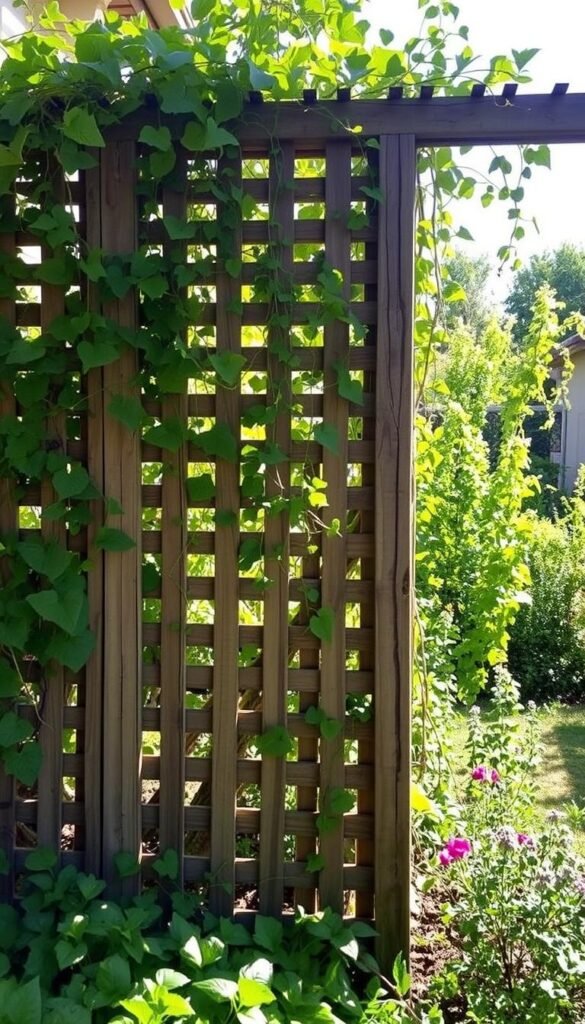
Turn overlooked corners into private sanctuaries with vertical structures that do double duty. These smart solutions shield your outdoor space from prying eyes while nurturing greenery upward. Let’s explore how to craft secluded areas that thrive with life.
Using Trellises as Privacy Screens for Intimate Spaces
Cedar frameworks excel at creating natural barriers between properties. Their spaced slats filter sunlight beautifully while supporting tall hedges. West-facing installations become magical at dusk, casting elongated shadows through the woodwork.
For year-round coverage, pair these structures with evergreen climbers like Boston ivy. The layered approach works wonders:
| Plant Type | Growth Speed | Best Use |
|---|---|---|
| Fast-growing vines | Quick coverage | Immediate screening |
| Woody climbers | Permanent structure | Long-term privacy |
| Seasonal bloomers | Color accents | Visual interest |
Layering Climbing Plants for a Lush Living Wall
Combine different species for textured green walls that hide unsightly surfaces. Start with self-clinging ivy at the top, then add flowering clematis below. Finish with low-growing herbs at ground level for a fragrant, functional base.
Urban dwellers love how these layered systems transform concrete walls into thriving ecosystems. For design inspiration, consider mixing plant heights and leaf shapes. This creates depth while maximizing privacy in tight spaces.
Choose species with staggered bloom times to maintain visual appeal through seasons. Deciduous options provide summer shade and winter sunlight – perfect for south-facing areas. Evergreens keep their foliage year-round for constant coverage.
DIY Trellis Projects for Budget-Friendly Garden Upgrades
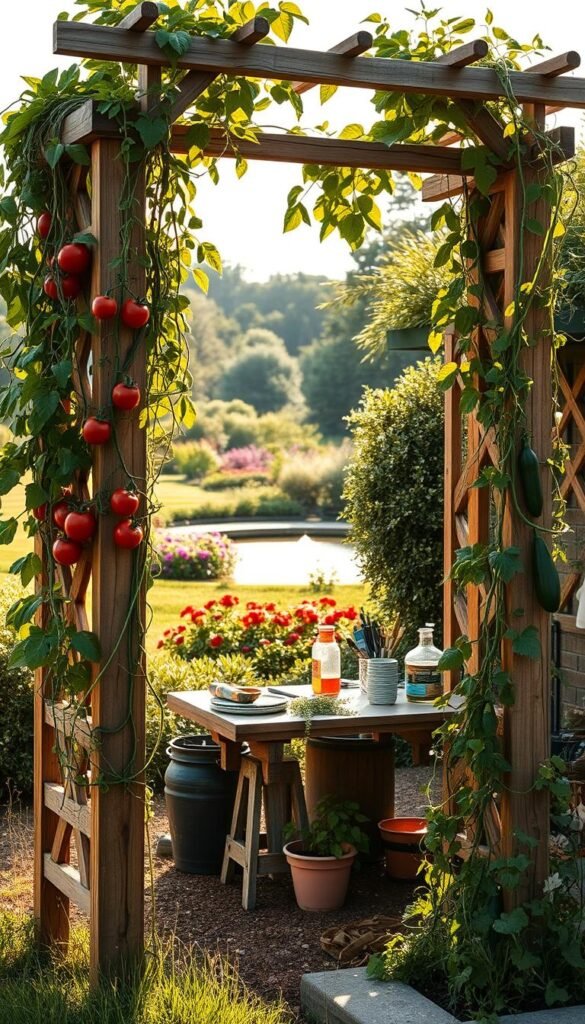
Transform everyday items into functional garden features without breaking the bank. With some creativity, you can craft sturdy plant supports that enhance your outdoor space while keeping costs low. Let’s explore how common materials become vertical growing solutions.
Upcycling Scrap Materials into Unique Trellises
Old wooden ladders make instant A-frame structures when anchored securely. Stack pallet wood vertically for peas to climb, or bend cattle panels into arched walkways. Even broken fence sections find new life as tomato towers when attached to T-posts.
Consider these cost-effective material options:
| Material | Average Cost | Best Use |
|---|---|---|
| Bamboo poles | Free-$10 | Bean teepees |
| Chain link pieces | $0-15 | Tomato grids |
| Cattle panels | $15-20 | Archways |
| Garden netting | $15/roll | Modular screens |
Zip ties transform chain link fragments into customizable grids. For quick privacy screens, cut 5×15′ netting into four sections. Attach to stakes using durable twine – you’ll get eight-foot supports for under $4 each.
Rebar stakes provide sturdy bases for branch structures. Weave flexible willow stems through horizontal supports to create natural-looking frames. These methods prove beautiful gardens don’t require expensive store-bought solutions.
Tips and Tricks for Supporting Climbing Plants Successfully
Matching greenery with its perfect partner makes all the difference in vertical gardening. The right pairing boosts plant health while creating eye-catching displays. Let’s explore how to maximize growth and style through smart combinations.
Expert Advice on Plant-Trellis Compatibility
Consider your plant’s weight and growth pattern first. Delicate vines like sweet peas thrive on lightweight bamboo grids, while heavy growers like grapes need sturdy metal frames. Self-clinging varieties (ivy, climbing hydrangea) work best on rough surfaces like brick or wood.
Attachment methods matter too. Use soft ties for tender stems – old nylon stockings prevent damage. For urban container setups, foldable wire panels offer flexibility. They support tomatoes or beans while fitting tight spaces.
Rotate crops annually to prevent soil depletion. Pair quick-growing morning glories with slower perennials for constant coverage. Remember: a well-matched system becomes part of your garden’s personality, blending practicality with natural beauty.

